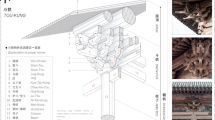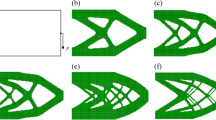Abstract
Recently, the construction of nested or sliced Latin hypercube designs (LHDs) has received notable interest for planning computer experiments with special combinational structures. In this paper, we propose an approach to constructing nested and/or sliced LHDs by using small LHDs and structural vectors/matrices. This method is easy to implement, and can generate nested and sliced LHDs through a unified algorithm. Moreover, an algorithm for improving the space-filling properties of the resulting designs is developed, and under some control the orthogonality of the constructed designs are attainable. Some examples are provided for illustrating the proposed algorithms.

Similar content being viewed by others
References
Ai MY, Jiang BC, Li K (2014) Construction of sliced space-filling designs based on balanced sliced orthogonal arrays. Stat Sin 24:1685–1702
Ba S, Myers WR, Brenneman WA (2015) Optimal sliced Latin hypercube designs. Technometrics 57:479–487
Chen H, Liu MQ (2015) Nested Latin hypercube designs with sliced structures. Commun Stat Theory Methods 44:4721–4733
Fang KT, Li R, Sudjianto A (2006) Design and modeling for computer experiments. Chapman and Hall/CRC, New York
Hickernell FJ (1998) A generalized discrepancy and quadrature error bound. Math Comput 67:299–322
Huang HZ, Yang JF, Liu MQ (2014) Construction of sliced (nearly) orthogonal Latin hypercube designs. J Complex 30:355–365
Huang HZ, Lin DKJ, Liu MQ, Yang JF (2016) Computer experiments with both qualitative and quantitative variables. Technometrics 58:495–507
Hwang Y, He X, Qian PZG (2016) Sliced orthogonal array based Latin hypercube designs. Technometrics 58:50–61
Johnson ME, Moore LM, Ylvisaker D (1990) Minimax and maximin distance designs. J Stat Plan Inference 26:131–148
Lin CD, Bingham D, Sitter RR, Tang B (2010) A new and flexible method for constructing designs for computer experiments. Ann Stat 38:1460–1477
McKay MD, Beckman RJ, Conover WJ (1979) A comparison of three methods for selecting values of input variables in the analysis of output from a computer code. Technometrics 21:239–245
Qian PZG (2009) Nested Latin hypercube sampling. Biometrika 96:957–970
Qian PZG (2012) Sliced Latin hypercube sampling. J Am Statist Assoc 107:393–399
Qian PZG, Tang B, Wu CFJ (2009) Nested space-filling designs for experiments with two levels of accuracy. Stat Sin 19:287–300
Santner TJ, Williams BJ, Notz WI (2003) The design and analysis of computer experiments. Springer, New York
Sun FS, Liu MQ, Qian PZG (2014) On the construction of nested space-filling designs. Ann Stat 42:1394–1425
Xie HZ, Xiong SF, Qian PZG, Wu CFJ (2014) General sliced Latin hypercube designs. Stat Sin 24:1239–1256
Yang JY, Liu MQ, Lin DKJ (2014) Construction of nested orthogonal Latin hypercube designs. Stat Sin 24:211–219
Yang X, Yang JF, Lin DKJ, Liu MQ (2016) A new class of nested orthogonal Latin hypercube designs. Stat Sin 26:1249–1267
Zhou Q, Jin T, Qian PZG, Zhou SY (2016) Bi-directional sliced Latin hypercube designs. Stat Sin 26:653–674
Acknowledgements
The authors thank the Editor-in-Chief and two referees for their valuable comments. This work was supported by the National Natural Science Foundation of China (Grant Nos. 11771220, 11431006, 11501305, 11601195 and 11601366), China Postdoctoral Science Foundation (Grant No. 2016M591378), Tianjin Development Program for Innovation and Entrepreneurship, Tianjin “131” Talents Program, and Project 613319. The first two authors contributed equally to this work.
Author information
Authors and Affiliations
Corresponding author
Rights and permissions
About this article
Cite this article
Guo, B., Chen, XP. & Liu, MQ. Construction of Latin hypercube designs with nested and sliced structures. Stat Papers 61, 727–740 (2020). https://doi.org/10.1007/s00362-017-0959-8
Received:
Revised:
Published:
Issue Date:
DOI: https://doi.org/10.1007/s00362-017-0959-8




